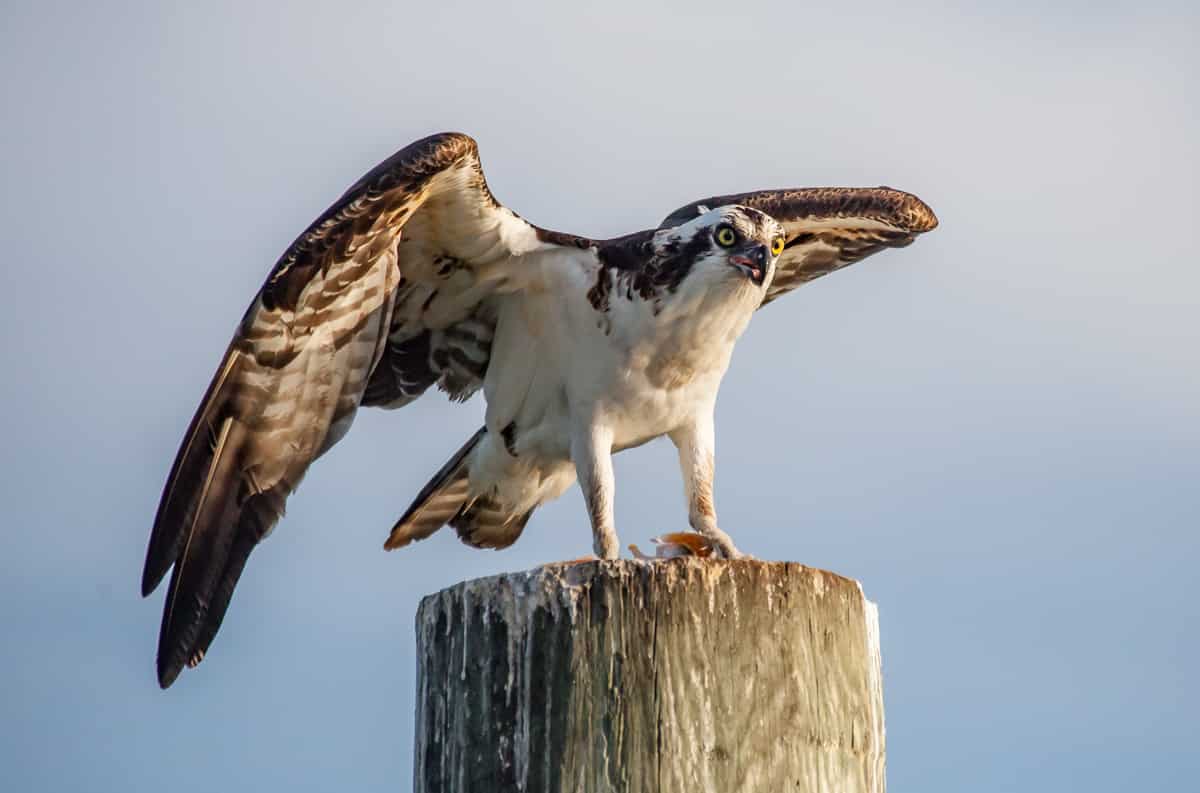Meet the osprey (Pandion haliaetus – they used all the vowels in this one) or in Spanish águila pescadora, a bird that’s so unique that it’s in its own taxonomic family.
So what makes the osprey so unique? Its diet. Ospreys are piscivorous, which is a fancy way of saying that they eat fish. And when I say they eat fish, I mean they almost exclusively eat fish. They’ve been documented eating carrion, lizards, small mammals and birds but up to 99% of their diet is of the slippery, finned variety.
Ospreys catch their underwater prey by flying 10 to 30 meters above the water and waiting for an unknowing fish to swim a little too close to the surface. When they spot a suitable target, they dive towards the water with their wings tucked backwards and their talon-tipped legs extended forward. They hit the water feet-first, sometimes diving completely underwater. They grab their slippery target with both feet, flap their way out of the water and find a nearby perch to enjoy their meal.
Their specialized diet of fish has resulted in the evolution of unique physical characteristics that allow them to succeed as fisherman, or fisherbirds, I guess. First, they have very interesting, fish-grabbing feet that are made to hold onto the slick skin of a fish. The bottom of their toes have something called spicules which are tiny spines on the underside of the toe that help the osprey hang on to a wriggling fish. They also have extremely long talons that sink into their prey.
They’ve even evolved to use these fierce, spikey feet in a unique way. Normally, their four toes are spaced in a three in front, one in back manner, but they have the ability to swing one of their toes around for a two in front, two in back alignment that helps them hold on to a fish struggling for its life.
Additionally, it’s not just their feet that help succeed as aerial fisherman. They also have oily feathers that make them waterproof and valves that seal their nostrils when they hit water.
As one might guess, ospreys are found near water. They happily hunt in the fresh and salt water of every continent except Antarctica. In Costa Rica, they’re found along both coasts as well as rivers and lakes in the interior of the country. In much of their worldwide range ospreys are migratory, which is mostly the case for Tico ospreys. Birds that summer up north fly down to enjoy the warm weather from September to April.
Since I live on the Pacific coast and have several camera trap projects in the area, I frequently get to enjoy the sight of ospreys fishing. I’ve seen them dive into the warm waters of local beaches and fly off with a fish taking its first and last flight. I’ve also seen them at Lake Arenal and Río Cañas, dining on freshwater fish.
I’ve recorded ospreys on my camera traps a handful of times. Once, I recorded one investigating a jabiru nest that I was monitoring. On two other occasions, I recorded ospreys by placing a camera trap in a tree that was dangerously hanging over the edge of a cliff, high above the ocean.
On both occasions, I thought about how much my mom would hate what I was doing but it was worth it to record such an interesting bird. Take a look at the video below and meet the osprey.
About The Author
Vincent Losasso, founder of Guanacaste Wildlife Monitoring, is a biologist who works with camera traps throughout Costa Rica. Learn more about his projects at: Instagram and facebook or by email.

